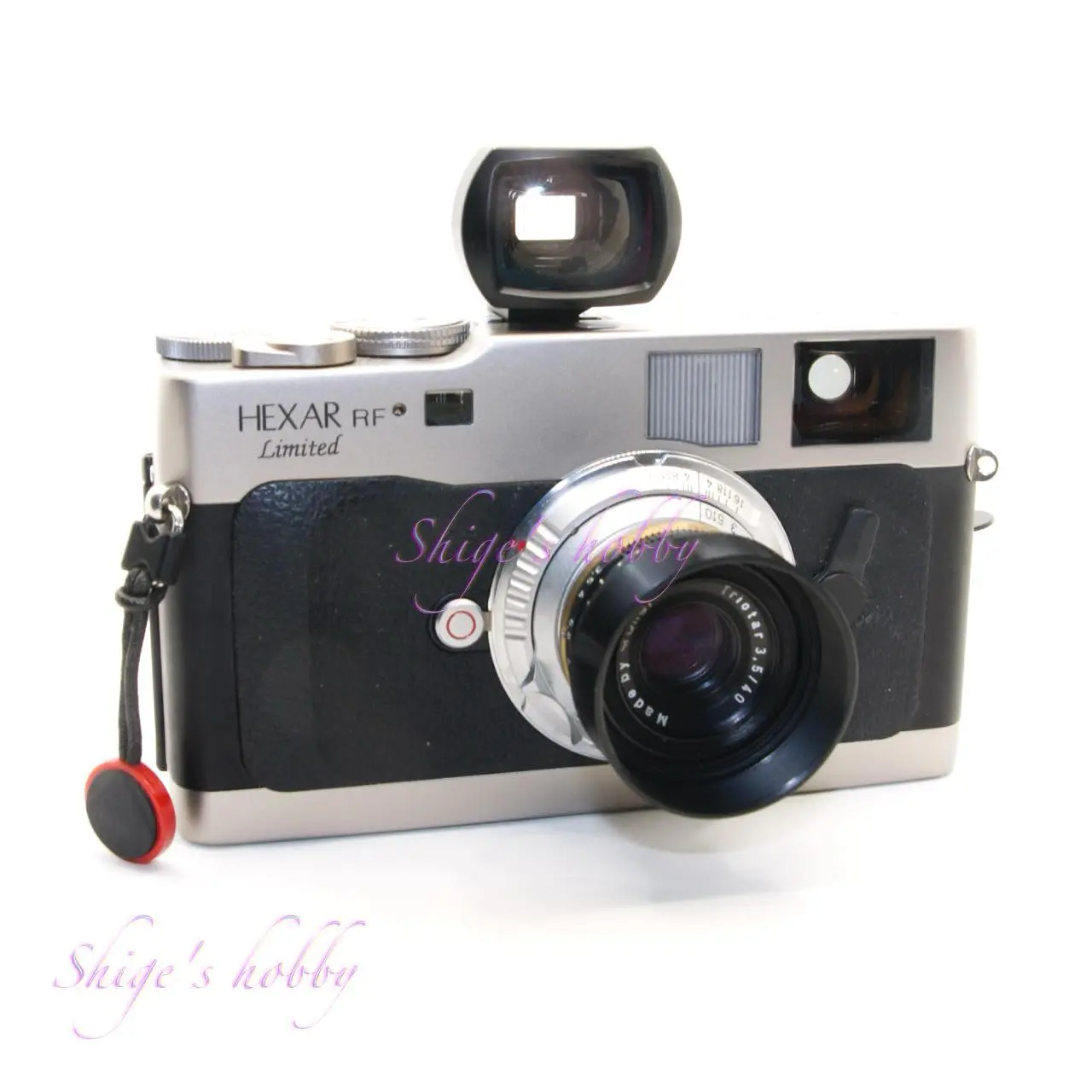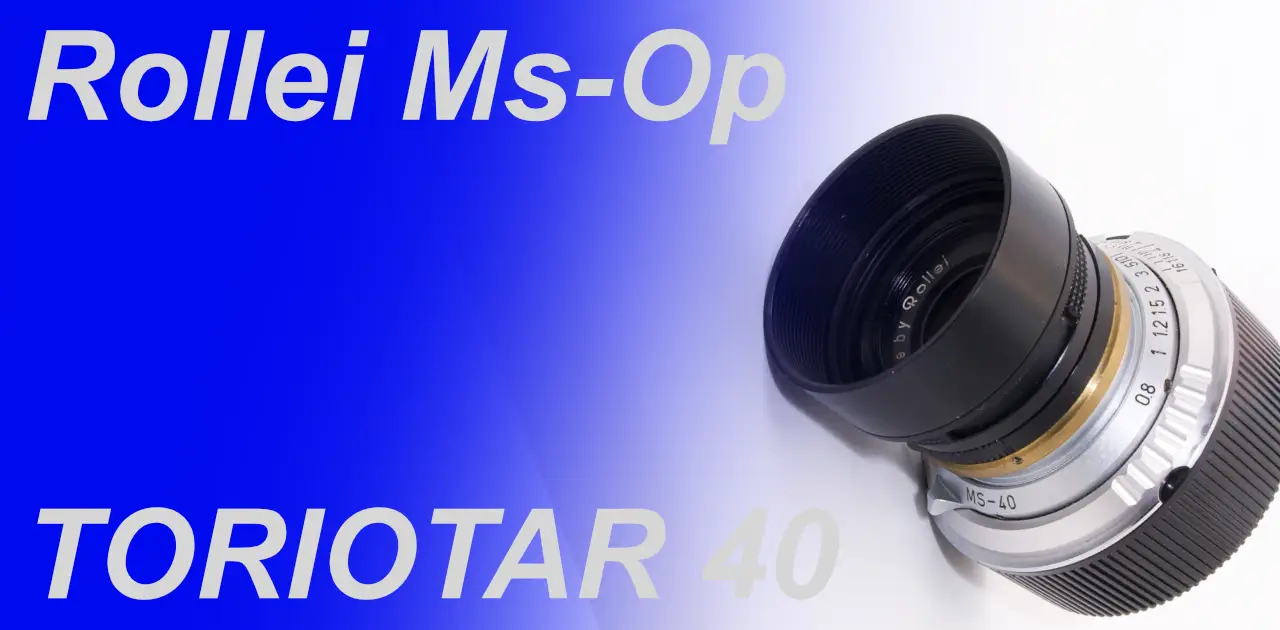A review and sample photos of the TRIOTAR 40mm lens, originally from a Rollei 35B and converted to a Leica M-mount by Ms-Optics, used with a HEXAR-RF film camera and a HASSELBLAD X2D-100C digital mirrorless camera.
- Please see the disclaimer regarding advertising here.
- Italicized links in the text are advertisement links that take you to other sites.
Table of contents
Gallery
The sample photos were taken using the following camera.
- KONICA HEXAR-RF +LOMO CHROME 100
- KONICA HEXAR-RF +LOMO NEGA 800
- SONY α7Sii
- SONY α NEX-7
- LEICA T typ701
Review


1.Overview
The TRIOTAR 40mm Ms-Optics modified lens is a modified lens created by removing the lens from a compact film camera, the Rollei B35 (35B) or C35, and mounting it onto an Ms-optics M-mount helicoid, the MS-40.
The M-mount helicoid MS-40 is a universal helicoid for lenses with a focal length around 40mm. During the modification process, it is adjusted to a 40mm focal length, allowing for focusing using the rangefinder of an M-type rangefinder camera through double image coincidence.
The minimum focusing distance of the modified lens is 0.8m, and the original 6-blade aperture is retained.
The lens barrel also utilizes the original barrel, which is fixed at the infinity position, and the helicoid for focusing is integrated into this structure. The MS-40 helicoid is designed for versatility, allowing various lenses to be converted to M-mount.
When the lens is mounted on an M-type Leica-compatible camera, the viewfinder frame displays the 35mm frame. For a 40mm focal length, you can use an external 40mm viewfinder or use the inner area of the 35mm viewfinder frame as a guide.
This particular lens appears to be an older modification, with a silver barrel color, a fixed original helicoid, and a fixed, directly attached lens hood.
More recently modified lenses may have a black helicoid and a working original helicoid, allowing for close-up photography with mirrorless cameras. Even with older fixed models, this isn’t a major problem, as close-up photography is still possible with a mirrorless camera by using a mount adapter with an auxiliary helicoid.
2.Usability
The image quality of the TRIOTAR 40mm lens modified by Ms-Optics is characterized by its simple triplet design with three elements. While the image quality is slightly reduced at the edges, it produces images with good clarity and contrast.
The Rollei 35 series film cameras require focusing by estimation, often resulting in shooting with a stopped-down aperture. However, this lens, modified by Ms-Optics to fit a Leica M mount, allows for accurate focusing from wide open aperture using the rangefinder’s split-image focusing system.
The operation is typical of Ms-Optics modified lenses, with smooth helicoid movement. Although the aperture ring lacks click stops, its position is separate from the focus ring, preventing accidental movement of the aperture ring during shooting.
■Film rangefinder camera
When I acquired this lens, I had already gotten rid of my digital rangefinder camera, so the evaluation is based on its performance with a film rangefinder camera.
I used both reversal film and negative film with the film rangefinder camera. The reversal film was expired LomoChrome 100, so I’m unsure if the color tone and grain are accurate, but it has a graininess and warmth similar to KODAK E100G. In terms of lens resolution, I’m quite satisfied with the image quality on ISO 100 reversal film.
I used a coarse ISO 800 negative film, and while the graininess is noticeable, the subject is clearly resolved.
At the maximum aperture of F3.5, the accuracy of the focus using the double image coincidence method on the HEXAR-RF is not a problem.
■Digital mirrorless camera
Mirrorless cameras offer a diverse lineup in terms of pixel count: the Sony α7Sii has a 12-megapixel 35mm full-frame sensor, the Sony α NEX-7 has a 24-megapixel APS-C size sensor, and the Leica T typ701 has a 16-megapixel sensor.
The α7Sii, with its larger sensor size and 12-megapixel resolution, effectively masks the image quality issues that can occur at the edges of the frame when using a triplet lens.
Both cameras equipped with APS-C size sensors utilize a focal length of 40mm * 1.5x, resulting in an effective focal length of 60mm. This allows them to utilize the optimal central portion of the lens, fully leveraging the 24-megapixel resolution.
When using these cameras with a mirrorless system, using a mount adapter with an auxiliary helicoid allows for close-up photography.
■Medium format digital mirrorless camera
The HASSELBLAD X2D-100C is a mirrorless camera equipped with a medium-format digital sensor. The sensor size is larger than 35mm film, and the focal length conversion factor compared to 35mm film is 0.8x. If the image circle covers the medium-format digital sensor, it becomes equivalent to a 32mm wide-angle lens.
The TRIOTAR, like other triplet lenses, has a wide image circle. As shown in the example below, when shooting with a 44mm x 33mm medium-format digital camera sensor, vignetting is only present in a small area around the edges, and it can be fully utilized in situations where some vignetting is acceptable. For a smaller 3:2 aspect ratio 44mm x 30mm sensor, it has a practically usable image circle in almost all situations.
Furthermore, it can handle the 100-megapixel sensor resolution to some extent, providing sufficiently usable image quality unless cropping at 1:1 magnification. It also performs reliably in backlit situations without producing overly distracting flares.
The lens I own has a fixed hood, which may affect the rendering in backlit situations. However, since the hood cannot be removed, I cannot confirm the rendering without the hood.
The X2D-100C lacks a shutter mechanism in the camera body, so it uses an electronic shutter. Therefore, it’s necessary to be mindful of rolling shutter distortion in the subject. Among mirrorless cameras with similarly sized medium-format digital sensors, the Fujifilm GFX series has a mechanical shutter built into the body, making it easier to use with Leica M-mount lenses.

3.Summary
In conclusion, to summarize the TRIOTAR 40mm Ms-Optics modification, although it’s a lens originally mounted on a lower-cost version of the Rollei 35, the central image quality produced by the three-element Triotar lens is excellent.
Even when used with a 44 x 33mm medium format sensor, vignetting is minimal, and while the image quality at the edges is somewhat questionable since it’s outside the 35mm full-frame sensor area, it’s perfectly usable in some situations.
Among the M-mount lenses I own that have been converted from compact camera lenses, this one provides good image quality.
Specifications, considerations, etc.
The compact film camera Rollei 35 series has four types of lenses: Sonnar (five elements in four groups), Tessar (four elements in three groups), Xesnar (four elements in three groups), and Triotar (three elements in three groups). Sonnar is the most luxurious lens, and Triotar is the least expensive. This can be seen from the lens configuration of Triotar, which is three elements in three groups.
Although it is inexpensive, it is true that there are voices that appreciate Triotar, which shows that the lens is a big factor of preference. Rollei film cameras are not that expensive regardless of the lens they are equipped with, and it seems that the cost of modification is higher. It is interesting that they dared to modify this lens to a Leica M mount under those conditions.
Ms-optics does a lot of work converting compact camera lenses into lenses for Leica M-compatible rangefinder cameras. This lens is one of them.
The focal length of 40mm is a major focal length for compact cameras, and it is not too wide or too narrow, so it can be said to be a compromise that allows this lens to be used in all shooting situations.
Since zoom lenses became mainstream for compact cameras, the lens focal lengths of compact cameras equipped with prime lenses have become mainstream at 28mm and 35mm, with 40mm falling out of use.
| Items | TRIOTAR | Sonnar LSM | SUMMARIT | NOKTON | SUMMICRON C |
| Manufacturer | Rollei | Rollei | LEICA | Voigtlander | LEICA |
| Focal length(mm) | 40 | 40 | 40 | 40 | 40 |
| Max aperture | 3.5 | 2.8 | 2.4 | 1.4 | 2 |
| Min aperture | 16 | 22 | 16 | 16 | 16 |
| Aperture balade | 6 | 10 | 12 | 10 | 10 |
| Lens Construction | 3 elements in 3 groups | 5 elements in 4 groups | 6 elements in 4 groups | 7 elements in 6 groups | 6 elements in 4 groups |
| Min distance(m) | 0.8 | 0.7 | 0.8 | 0.7 | 0.8 |
| Lens length(mm) | 39 (including hood) Hood length 12.5 | 30.5 | 21 | 29.7 | 23.5 |
| Lens Max diameter(mm) | 49 | 51 | 49 | 55 | 50 |
| Filter Size(mm) | – | 39 | 37 | 43 | 39 |
| Lens hood | Direct mounting | Special food | Cylindrical screw-in hood | Bayonet hood LH-6 | Trumpet-shaped screw-in hood 12518 |
| Release date | ? | 2002〜2006 | 1995 | 2004 | 1972 |
| Production numbers | ? | ? | 120,000 | – | 54,350- |
| Weight(g) | 103 | 172 | 54 | 175 | 120 |
Reference links
Affiliate links
- Please see the disclaimer regarding advertising here.
- Italicized links in the text are advertisement links that take you to other sites.
- Leica Lens・Ads by Amazon
- Leica Books・Ads by Amazon
- Ms-optics・Ads by Amazon
- TRIOTAR 40mm・Ads by ebay

Amazon Prime Sale
Update history
- 2025.11.11
- 2025.6.25
- 2024.12.9



Be First to Comment